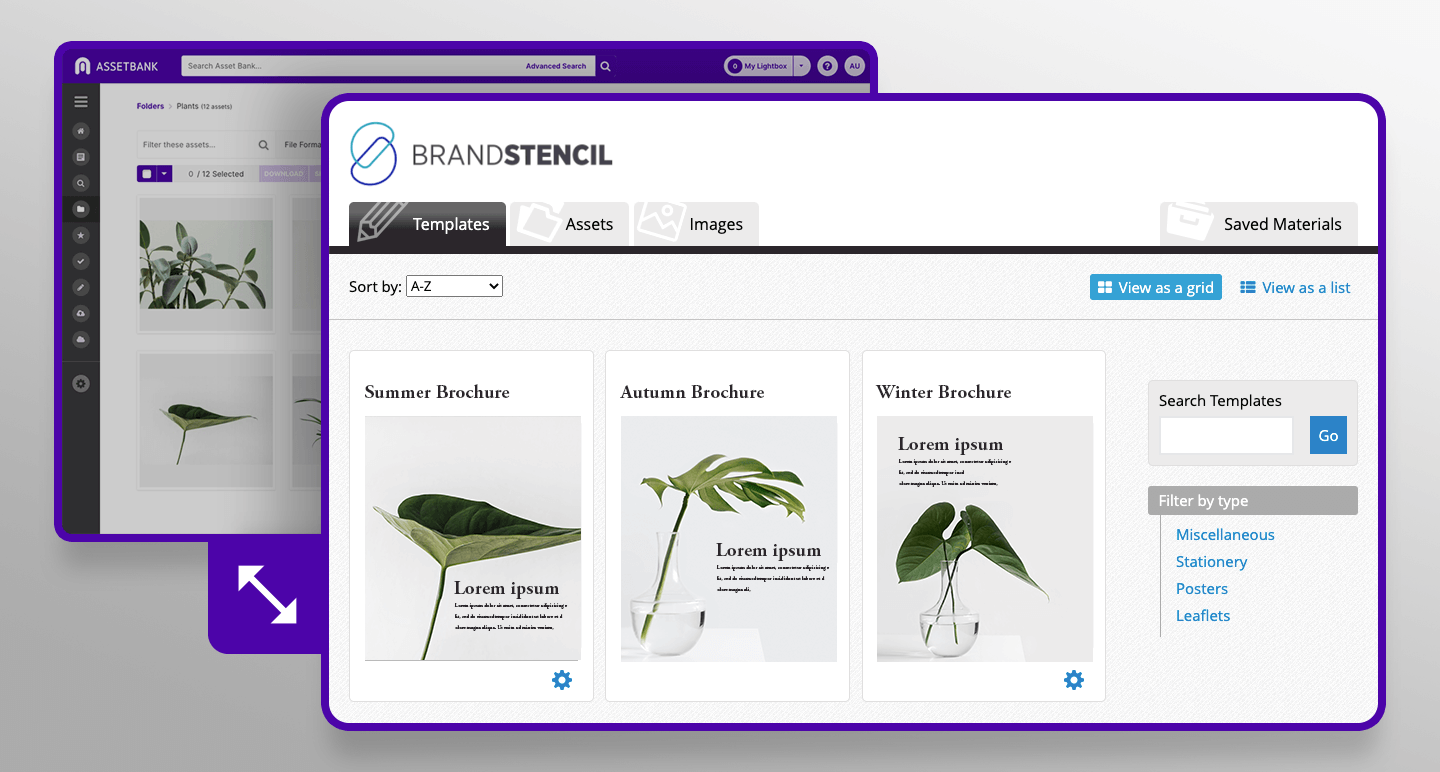
How to Integrate Asset Bank into Your Current Tech Stack
If you’re responsible for IT in your company, you’ll know there’s no shortage of software that promise improved efficiency and profitability. It can be difficult to decide what will meet your organisation’s objectives and fit best with your existing applications. And let’s not forget that all-important ROI.
This article aims to help non-marketers understand the benefits of integrating Digital Asset Management software into their organisation’s software stack. You’ll discover:
- The benefits of integrating software into a stack
- Why DAM is essential for modern marketing teams
- Some common DAM integrations and their benefits
- Five essential considerations before integrating DAM into your stack
- Three foundations for successful DAM integration
- How Asset Bank DAM integrates by design
Let’s go.
The benefits of integrating software into a stack
Scott Brinker - aka Chief MarTec - estimates there are now over 14,000 marketing software solutions in the market. These include creation, management, outreach and publishing tools like CRM, CMS, design software, email marketing platforms and more.
It’s likely that your marketing team already use a number of these. In fact, most marketing teams surveyed use between 20 and 29 separate tools.
IT experts know that these separate solutions should be integrated into a tech stack to deliver the best outcomes. The research above shows that failure to incorporate tools actually leads to increased manual work, eating into any productivity gains.
Integrating software reduces the friction between them. It can create seamless, semi-automated workflows that span multiple tools. This improves transparency, productivity and collaboration.
For example:
- Staff can access functionality from one tool within another, reducing time wasted clicking between systems
- Tasks can be automated, reducing manual interventions and the risk they represent
- Internal and external contributors can collaborate more easily and securely
- Managers have improved oversight of performance and progress
It can be a challenge to get them all working together. You need to establish optimal workflows and then get the systems sharing and syncing data.
But - ultimately - many businesses believe the long-term boost to productivity and efficacy makes the short-term effort worthwhile.

Never miss an update from us.
Get doses of brand, marketing and tech delivered directly to your inbox!
Why DAM is essential for modern marketing teams
Digital Asset Management software provides a centralised, single source of truth for all digital assets in an organisation. Think logos, photos, videos, artwork, podcasts, documents…
Most organisations have 100,000s of digital assets. Maybe millions. And DAM makes sure everyone can access them within just a couple of clicks (so long as they have permission to, of course).
This functionality is especially valuable for marketing teams, especially in larger organisations.
Marketers need to create high-quality content for lots of channels - digital, print, social media - and they need to do it quickly. Sales depend on them getting marketing materials to market ASAP.
To do this, they create and use thousands of digital assets. A single photo shoot can create 100s of individual files. So they need a way to manage and access these assets at speed.
Any time wasted - looking through confusing file structures to find photos, working out which video edit is the right one to use - causes costly delays to market.
Cumulatively, these individual inconveniences can add up to days of wasted time each month. This is why Digital Asset Management is a strategic and competitive must-have for modern marketers.
Some common DAM integrations and their benefits
Marketers use digital assets across every channel. They’re not restricted to being used only online or just in an email campaign.
Your marketers need fast access to assets for websites, social media, emails, digital and print ads, publications, radio, apps and more.
This means a DAM system can be productively integrated with every tool your marketers already use - saving them time and boosting productivity as a result.
Here are just three of the most common DAM integrations we regularly set up for our clients.
Design software
Whether in-house or via external agencies, your marketing team will create a lot of original artwork. That’s why we offer integrations that let any staff member create high-quality on-brand designs, even with no design experience.
Our integrations with WeBrand and BrandStencil empower staff to create branded documents using pre-approved templates and images. If your marketing team are usually tasked with creating every single bit of artwork for the organisation, this is a game-changer.
 Asset Bank and BrandStencil
Asset Bank and BrandStencil
Content Management System (CMS)
A CMS is used to manage websites. Users can create and edit pages, adding text, video, images, audio etc. Most CMS include a media library that stores uploaded digital assets. But this falls very short of full DAM functionality. For example, it has very limited browse and search functionality. Plus staff need to upload assets that have already been formatted for web use.
If you integrate your DAM with your CMS, users can easily access any of your digital assets from within the CMS.
They can browse for the best assets based on attributes like colour or content. They can edit assets to make them fit for purpose before publishing them online. And they can choose any assets - even if it isn’t in a web format - and the DAM will convert it on the fly.
Asset Bank has a CMS Integration Module that’s been designed to make it quick and easy to link Asset Bank with almost any Content Management System. We’ve also got built-in integrations with common CMS like WordPress and Drupal.
Project management and collaboration tools
DAM also loves being paired with project management tools. Marketing is a collaborative discipline, with lots of stakeholders involved in signing off campaigns and concepts. Integrating your DAM with PM software helps streamline this process.
For example, Asset Bank integrates with Ziflow. Ziflow lets collaborators work on digital assets together - annotating them with amends, comparing versions - and then Asset Bank automatically saves them to your DAM. This speeds up approval workflows and keeps a full audit trail of the sign-off process.
Five essential considerations before integrating DAM into your stack
If you’re an IT pro, feel free to skip this section. For everyone else, here’s a quick overview of what you need to know before integrating DAM into your stack.
Means of integration
There are several ways to integrate software, including APIs, webhooks and middleware.
- API stands for ‘application programming interface’. A software developer can access and modify software with an open API, so it works with other applications. Asset Bank has REST API built-in.
- Webhooks communicate with one another automatically. When changes are made in your DAM, or another app in your ecosystem, they can automatically update each other with the new information.
- Middleware is like a bridge between two applications. It helps translate data from one system into something another system can understand.
Security and user authentication
When you integrate software into a single stack, users can typically use a single sign-on and access everything without logging in again. This puts an end to the pain of remembering multiple passwords. You could also implement two-factor authentication with your SSO provider if you need enhanced security for your digital assets.
Cost
Some software vendors apply usage-based costs for integrations, so you’ll need to explore these to ensure they’re not prohibitive. If you want to build custom integrations, you’ll need to factor in the time and cost for developers.
Frequency of synchronisation
Syncing between software means that users can see up-to-date information and assets from anywhere in your system. But syncing can sometimes cause performance to temporarily slow. Think about the frequency of synchronisation that’s best for your business. Aim for something frequent enough that users can work efficiently, but not so frequent that it impacts overall performance. Consider optimising performance with caching.
Hosting method
You’ll also need to think about how your software is hosted. Typically this will be on-premise, in the cloud, or a hybrid of the two. Cloud-based software (Software as a Service / SaaS) is typically easier to integrate than software hosted on your own servers, as it is built with flexibility and integration in mind.
Read more about cloud-based vs on-premise DAM
Three foundations for a successful DAM integration
If you’re ready to integrate DAM into your software stack, lay the foundations for success with the following three steps.
Get your developers/vendors in the loop ASAP
Your vendors know their software better than anyone. They’re likely to have dealt with similar requests in the past and can tell you what is and isn’t possible. Next, get your developers on board to discuss feasibility, practicalities and cost.
Audit current systems and workflows
Software isn’t a magic bullet. It can improve productivity up to a point. But your processes need to be fit for purpose too. No software can fully compensate for outdated or ineffective ways of working. If you’re planning to overhaul your software stack, start by auditing your current processes and workflows.
Define your scope and map your data
Once you’ve established your ideal workflow and worked out what software you need, you need to map it out. How does work progress through the system and what data needs to go back and forth between software? Document this so everyone knows what’s expected and you have something to check against when testing the system.
How Asset Bank DAM integrates by design
We’ve already touched on some of the integrations Asset Bank offers as standard. Here’s a quick round-up of how we’ve developed Asset Bank to fit flexibility into your stack and optimise the tools you already use.
- Cloud-based / SaaS hosting model - This makes it much easier to integrate us with your existing tools
- REST API functionality - Our API means your developers can build custom integrations with other applications
- Single Sign-On and simple authentication - We offer Single Sign-On, which minimises password pain for your users
- Existing integrations with other apps - We’ve already got built-in integrations with a whole heap of other marketing and publishing applications, like WordPress
- Asset Transformer module - Transform digital assets and use Amazon CloudFront CDN to serve them to your ecommerce site, optimised for lightning-fast load time
- Publishing module - Set up match criteria - like all images marked ‘approved for public use’ - and have them published to a different server, ready for use by another system
- Support team - Our support team will work with your IT team and developers to create bespoke integrations that harness our functionality in other tools
With the majority of marketing teams using dozens of different systems, integrating apps is key to productivity and profitability. If you’d like to discuss integrating Asset Bank DAM into your software stack, get in touch today.

